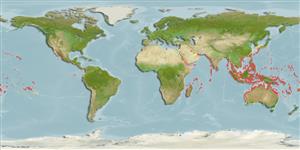Common names from other countries
Classification / Names / Names
Common names | Synonyms | Catalog of Fishes (gen., sp.) | ITIS | CoL | WoRMS
Environment: milieu / climate zone / depth range / distribution range
Ecology
Benthic; depth range 0 - 20 m (Ref. 349). Tropical
Indo-Pacific.
Length at first maturity / Size / Weight / Age
Maturity: Lm ? range ? - ? cm Max length : 18.0 cm ShH male/unsexed; (Ref. 349); common length : 13.0 cm SHL male/unsexed; (Ref. 349)
Mainly collected for its shell (Ref. 349). Occurs at the low tide mark (Ref. 349).
Life cycle and mating behavior
Maturity | Reproduction | Spawning | Eggs | Fecundity | Larvae
This species is a non-broadcast spawner. Life cycle does not include trocophore stage. Also Ref. 833.
Poutiers, J.M. 1998. (Ref. 349)
IUCN Red List Status (Ref. 130435)
CITES status (Ref. 108899)
Not Evaluated
Not Evaluated
Threat to humans
Harmless
Human uses
Fisheries: commercial
| FishSource | Sea Around Us
Tools
More information
Age/SizeGrowthLength-weightLength-lengthMorphologyLarvaeAbundance
Internet sources
Estimates based on models
Preferred temperature
(Ref.
115969): 24.6 - 29.3, mean 28.4 (based on 3457 cells).
Vulnerability
Low vulnerability (10 of 100).
Price category
Unknown.
